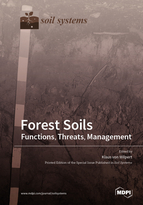Forest Soils: Functions, Threats, Management
A special issue of Soil Systems (ISSN 2571-8789).
Deadline for manuscript submissions: closed (28 February 2022) | Viewed by 32052
Special Issue Editor
Special Issue Information
Dear Colleagues,
The specific characteristic of forest soils is their long-term development under a more or less continuous vegetation cover. Trees as long-living organisms and through their magnitude, shape soils in a specific way. A, compared to other land-use types, deeper-reaching rooting zone and high activity of microbes, soil fauna and plant roots result in high humus contents as well as over-proportionally high porosity and continuity of the soil pore system. Forest soils are the habitat of a high diversity of plants, macro-fauna and microbes. Biological networks like the manifold symbioses between trees and mycorrhiza fungi optimize the supply of trees with nutrients and water. Contamination with pesticides is comparably low in forest soils, since forests are nature-near ecosystems. Moreover the high demand of trees and soil biota for essential nutrients like phosphorous and nitrogen leads to low leaching rates of those elements in most forest soils. Both, the low load with pesticides and low leaching of phosphorous and nitrogen make forests to sources of predominantly pure drinking water.
However, some of these functions of forest soils are endangered under the influence of environmental - and climate change or even because of inadequate forest management measures under some circumstances. E.g. the high crown surface of forest combs out acids and nitrogen from air pollution which lead to severe soil acidification in wide parts of Central Europe and other industrialized regions. Also the use of heavy forest machinery can cause soil compaction leading to deficits in soil aeration which can restrict the rooting space for forest trees to the uppermost soil layers. Moreover the optimization of the C-sequestration and greenhouse gas balances of forest soils through specific forest management practices is a topic of high actuality.
The scope of the special issue is to address the specific functions of forest soils, processes which endanger the integrity of these functions and management approaches to counteract the threats of soil functions and to preserve or recover them.
Dr. Klaus von Wilpert
Guest Editor
Manuscript Submission Information
Manuscripts should be submitted online at www.mdpi.com by registering and logging in to this website. Once you are registered, click here to go to the submission form. Manuscripts can be submitted until the deadline. All submissions that pass pre-check are peer-reviewed. Accepted papers will be published continuously in the journal (as soon as accepted) and will be listed together on the special issue website. Research articles, review articles as well as short communications are invited. For planned papers, a title and short abstract (about 100 words) can be sent to the Editorial Office for announcement on this website.
Submitted manuscripts should not have been published previously, nor be under consideration for publication elsewhere (except conference proceedings papers). All manuscripts are thoroughly refereed through a single-blind peer-review process. A guide for authors and other relevant information for submission of manuscripts is available on the Instructions for Authors page. Soil Systems is an international peer-reviewed open access quarterly journal published by MDPI.
Please visit the Instructions for Authors page before submitting a manuscript. The Article Processing Charge (APC) for publication in this open access journal is 1800 CHF (Swiss Francs). Submitted papers should be well formatted and use good English. Authors may use MDPI's English editing service prior to publication or during author revisions.






